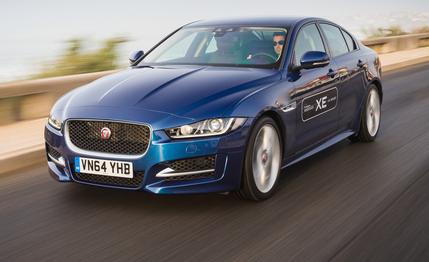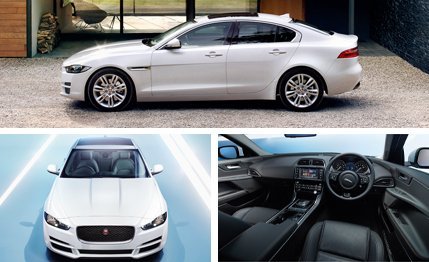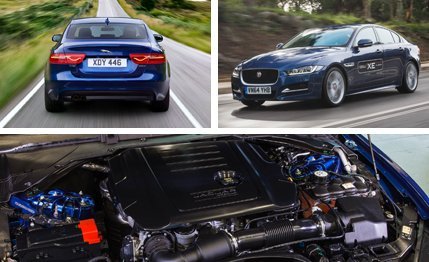 First Drive Review
First Drive Review
For those not keeping score at home, a quick recap of the state of the sports sedan: In May 2013, a Lexus IS350 F Sport beat out a BMW 335i M Sport in a three-car comparo. Ten months later, the 3-series’ two-door twin lost to an Audi S5. Then our annual 10Best Cars awards arrived for 2015 without a single 3-series variant on the list for the first time in 23 years.
But it’s not just BMW that’s down and out. We can’t shake the feeling that the discerning driver is also on the losing team these days. Never mind the 707-hp Hellcats or that seemingly every automaker wants to build a mid-engined car. Product planners have abruptly decided that mass appeal and crisp dynamics are at odds with each other, and nowhere is it more obvious than in this sweet-spot compact-luxury segment that once so deftly combined sport, refinement, and practicality. The non–F Sport Lexus IS models are butter-knife dull. The Audi A4 mutes the analog art of driving with a digital sense of speed. Choose the wrong options and your BMW will be softer than the comparable Mercedes C-class.
All of which makes the 2017 Jaguar XE an anomaly and a heaven-sent savior. We’ve just taken our first drive in Britain’s first car in this segment since the Ford Mondeo–based X-type, and it’s so good that we can’t think of a reason to mention that grim, four-wheeled disappointment again for the rest of this story. The two XE variants we drove—the supercharged V-6 XE S and a 180-hp diesel—sit at opposite ends of the performance spectrum and yet they both demonstrated the reflexes and the grace that are conspicuously absent in the competition. Keep your enthusiasm in check, though, because we’re still roughly a year away from the XE’s U.S. arrival (hence the 2017 model year on this story).
Like the larger XF and XJ, the smallest Jag sedan wears a body structure made mostly from bonded and riveted aluminum. The steel bits—all four doors, the trunklid, and the floor pan aft of the rear seat—are strategically located to shift the weight distribution toward the driven rear wheels.

Yet Jaguar admits that its aluminum car isn’t exactly light. With the supercharged V-6 and rear-wheel drive, the XE weighs nearly 3700 pounds. That’s on par with the 3-series and about 100 pounds heavier than the neurotically optimized, steel-intensive Cadillac ATS. The claimed 53/47-percent front/rear weight distribution also fails to impress. Jon Darlington, XE engineering manager, says a lighter body-in-white allows Jaguar to use heavier, more complex suspension systems. Between this XE and the Ford F-150 (which now weighs about as much as a Chevy Silverado), we were ready to declare aluminum the official material of reduced expectations.
Then we hammered the XE over Portugal’s wandering two-lanes, connecting sun-bleached villages with a supercharged wail and a red blur. Behind the wheel, the pounds melt away in an effortless hustle that’s all precision and dexterity. Helped by adaptive dampers and brake-based torque vectoring, the XE S turns in quick, corners flat, and exits fast. A crease in the asphalt at the apex becomes a twitch in your palms, a flash of recognition in your brain, and a wiggle of your wrists, all without conscious thought. This is real, living, breathing steering feel, and the XE has it in spades. You’ll laugh, you’ll cry tears of joy, and you’ll marvel that this is Jaguar’s first use of electric power steering in a sedan. It is exceptional.
Despite providing such a faithful interpretation of what’s happening at the tires, the XE is never harsh. Jaguar engineers credit what they call an integral link rear suspension. A short, vertical link between the control arm and the wheel carrier isolates certain bushings so they react to cornering forces with minimal influence on ride quality, and vice versa. The bushings that affect handling are stiffened and those responsible for impact suppression are softened. It all appears to work as advertised. The XE carves as well as the Cadillac ATS yet has the compliance of a Mercedes-Benz C-class.
Power for the range-topping XE S comes from the 3.0-liter supercharged V-6 used throughout the Jaguar range. It excels in delivering its power, and it’s instantaneous, seamless, and strong all the way to the 7000-rpm redline. Given its 340 horsepower and 332 lb-ft of torque, we predict a zero-to-60-mph run near the head of the pack at 4.7 seconds. The excellent ZF eight-speed automatic—also used by BMW and Audi—is another reminder that no automaker should waste the time or money trying to develop something quicker, smoother, or smarter, because it’s likely an impossible task.
The V-6 engine is neither as honeyed nor as musical as the Audi S4’s engine of similar configuration, displacement, and output. But even if the Jag engine doesn’t achieve the same level of polish, the NVH team has done an admirable job of burying the unpleasant sounds and vibrations behind insulation and bushings. At full throttle, the supercharger is barely audible and the engine plays a subtler variation of the six-cylinder F-type’s rasp.
The 2.0-liter turbo-diesel four-cylinder is our first taste of Jaguar’s new Ingenium engine family, which will sever the final ties with Ford Motor Company once it’s been fully adopted. The characteristic diesel clatter is suppressed so well that the compression-ignition engine might be more refined than the V-6—at least relative to its peers. In the diesel, the eight forward gears do a fine job of keeping the engine parked in the window between the 317-lb-ft torque peak at 1750 rpm and the maximum power output of 180 horsepower at 4000 rpm.

Pirelli P7 Cinturato tires—which have compromised several BMW 3-series in our tests—dampen that wonderful steering feel found in the XE S, but the chassis motions are otherwise every bit as competent. Besides, the diesel has its own noble purpose. The EPA highway number should easily top 40 mpg, counteracting the thirst of an M3-fighting XE R-S performance model—not yet officially confirmed but we’ve heard it’s a go—for the purposes of corporate fuel-economy accounting.
The diesel’s aluminum block also will form the foundation for a gas-burning Ingenium four-cylinder. That turbocharged 2.0-liter will ultimately make up the bulk of U.S. sales, but we’ll have to wait about six months after the XE’s spring 2016 launch for its arrival. All-wheel drive will be optional with any engine, and we’re promised a six-speed manual for either of the four-cylinder engines, albeit only with rear-wheel drive.
Of course, the XE isn’t without flaw. The graphics of the new InControl system’s eight-inch touch screen are cleaner and crisper than those of the cluttered mess in current-gen Jaguars, but the underlying software appears to be plagued by the same problems, namely slow responses. Rear-seat space is also on the small side, but then trying to be all things to all people is exactly how this segment became so anesthetic.
You can buy a bigger back seat, a more opulent interior, a web browser on wheels, a suite of pseudo self-driving technology, or all four at once, but a car this engaging and this capable is now a genuine rarity in this class. The XE is proof that there’s at least one automaker still looking out for enthusiasts. The question is whether there are enough enthusiasts still looking for a car like the XE. We believe there are.